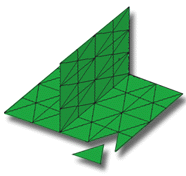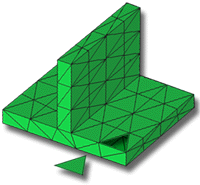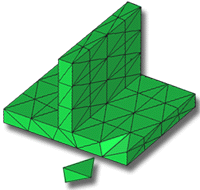Before you can run an analysis, you must have a meshed model. The mesh is a web that consists of elements, with each element containing a node at every corner. The mesh represents the part shape and provides the basis for the analysis, where molding properties are calculated at every node.
The selected mesh type, or analysis technology, determines which molding processes and which analysis sequences are available for selection.
The analysis technology types supported are:
Midplane analysis technology
A Midplane mesh provides the basis for the analysis. This mesh consists of three-node, triangular elements that form a one-dimensional representation of the part shape through its center, or midplane. The thickness of the part is represented by a thickness attribute applied to the mesh elements.
Midplane analysis technology is appropriate when the part is predominantly thin-walled.

Dual Domain analysis technology
A surface mesh provides the basis for the analysis. This mesh consists of three-node, triangular elements that form a one-dimensional representation on each surface of the part. The mesh elements are matched across opposing faces. The thickness of the part is determined by the distance between the opposing faces.
The model could be visualized as a hollow body covered with a surface shell.
Dual Domain analysis technology is appropriate when the part is predominantly thin-walled. If there are many thick regions, 3D analysis technology would be more appropriate.

3D analysis technology
A volume mesh provides the basis for the analysis. This mesh consists of solid, four-node, tetrahedral (tetra) elements; each tetra has four triangular faces and six sides.
3D analysis technology is appropriate for parts that have many thick regions because it gives a true 3D representation of the part.
